The iPhone SE Review
by Brandon Chester on May 16, 2016 8:00 AM EST- Posted in
- Smartphones
- Apple
- Mobile
- iPhone
- iPhone SE
System Performance
With the iPhone SE I've decided to make the transition to our 2016 benchmark suite. We've been including some of these for a little while now, and some tests from our previous suite are still around. There is one test omitted, which is Basemark ES / Basemark Metal, which we'll be deploying once we have all the data from this year's flagship Android smartphones. Comparisons to those Android phones will also have to wait until their respective reviews, and for now I can only really compare the iPhone SE to Apple's other iPhones along with 2015's flagship Android devices.
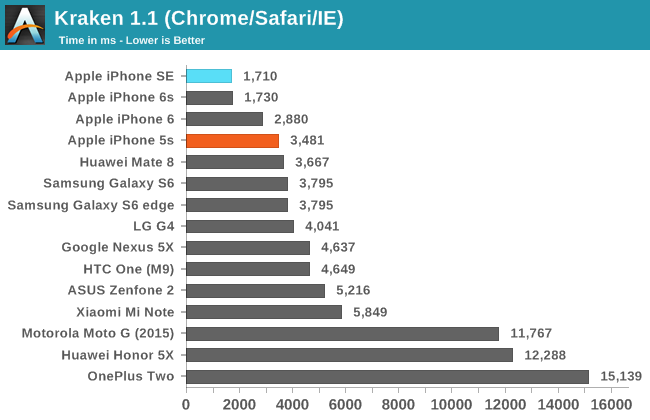
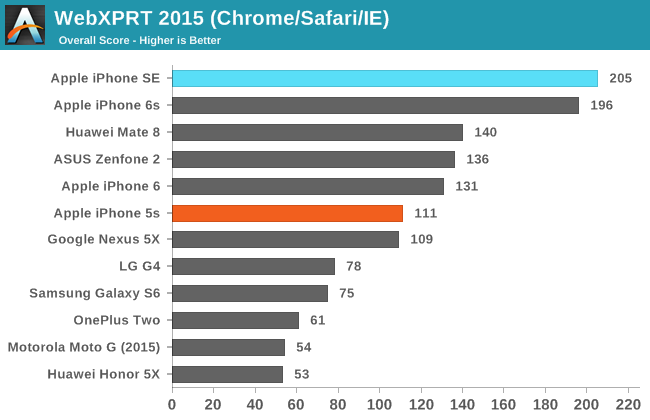
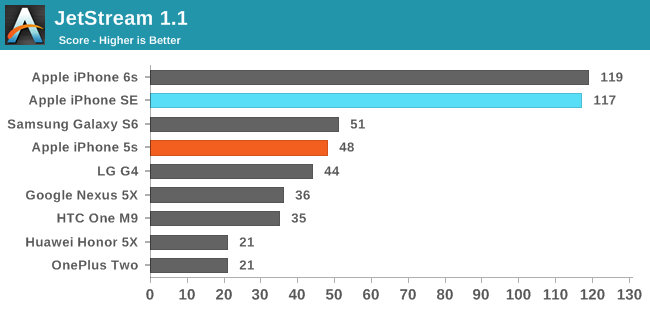
At this point I think we're ready to move to our 2016 web browser benchmarks. Octane is now retired, as there's a large degree of overlap between it and JetStream, with JetStream using a more sensible methodology with measurements for tests like the mandreel-latency test. Kraken, Octane, and Jetstream all have some overlap, but Kraken and JetStream are different enough to make it worth keeping Kraken on. Finally there's WebXPRT 2015, which we already introduced as a replacement for WebXPRT 2013 some time ago.
As expected, the iPhone SE matches the iPhone 6s in our JavaScript tests. The improvement over the iPhone 5s is significant, with roughly double the performance in all cases. This is right in line with Apple's 2x performance claim, and it's important to note that these are updated iPhone 5s figures run on iOS 9 to ensure that it also benefits from the improvements made to Apple's Nitro JavaScript engine since it launched in 2013.
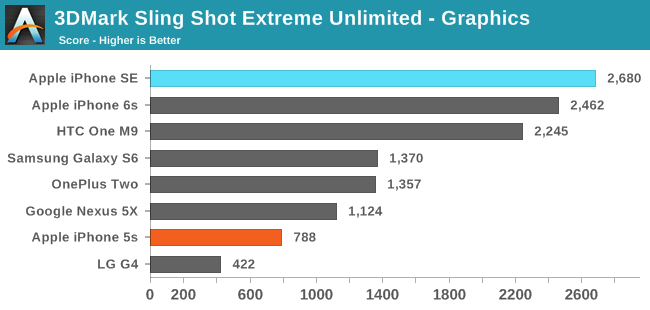
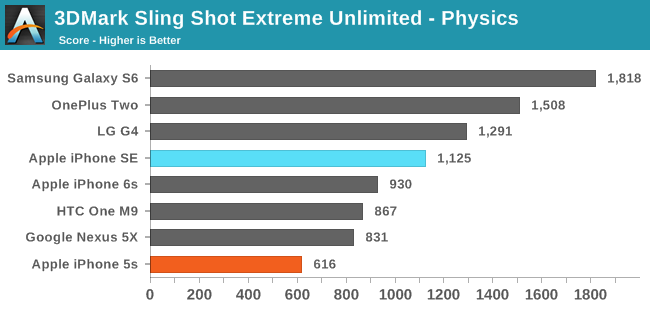
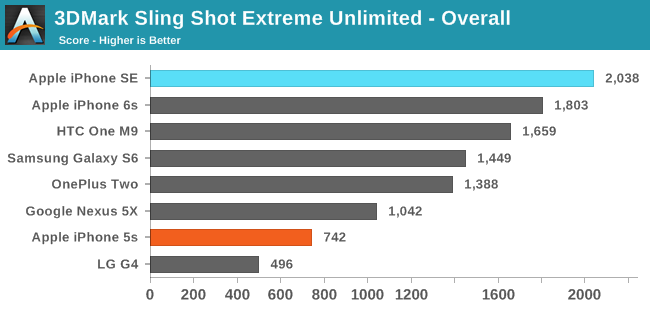
We originally planned to use 3DMark Sling Shot Unlimited, which is an OpenGL ES 3.0 test that runs off screen 1920 x 1080 tests to produce results that are useful for comparing devices and SoCs. However, in the interest of test longevity we have moved to the even newer Sling Shot Extreme test, which uses OpenGL ES 3.1 on Android and Metal on iOS, with a Vulkan version coming to Android in the future. The tests in Sling Shot Extreme render off screen at 2560 x 1440, so it should be a good target for GPU performance well into the future.
In this test the iPhone SE performs well. I experienced a strange situation where the iPhone 6s would consistently score lower than the SE, and I'm not sure if this is due to driver differences or some other problem, but in any case the SE and the 6s both end up at the top of the chart, and the final score is nearly three times higher than that of the iPhone 5s. I'm still waiting on final reviews for this year's Android flagships, so comparisons to Snapdragon 820 and Exynos 8890 will have to wait a bit longer.
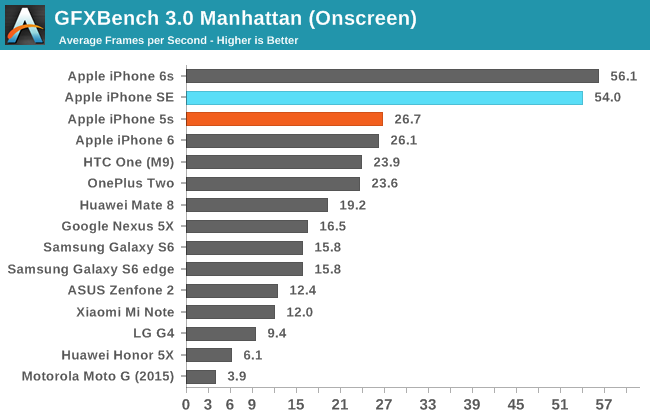
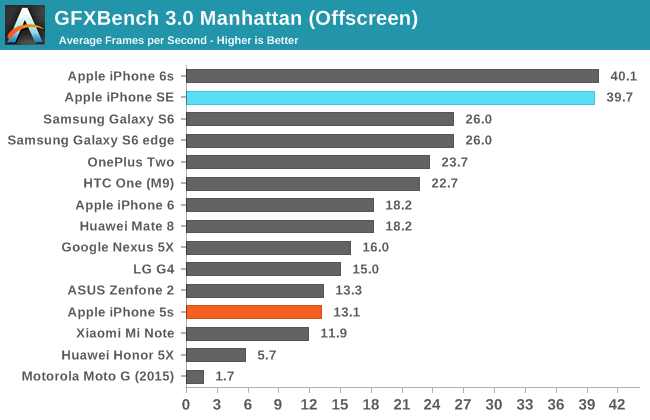
With T-Rex HD being such an old test, I've decided to retire it except perhaps for reviews of devices with relatively slow SoCs. That leaves GFXBench 3.0 Manhattan, and hopefully GFXBench 4.0 in the near future. In Manhattan the iPhone SE performs exceptionally well, achieving a frame rate that is ever so slightly more than three times that of the iPhone 5s. While there's obviously a degree of variance, I think this shows that Apple's 3x GPU performance claim is not an exaggeration, and on such a tiny display with a relatively low resolution you can render a scene like Manhattan at native resolution and almost achieve 60fps.
NAND Performance
With the first generation of the MacBook, Apple introduced their own PCI-E SSD controller with support for NVMe. At the launch of the iPhone 6s and iPad Pro, they noted that both devices had significantly improved storage performance. During the course of our review we discovered that Apple had essentially brought some version of their controller down to their mobile devices, and as a result they led the rest of the mobile market by a large margin when it came to overall storage performance.
With the iPhone SE, Apple uses the same controller as they do in the iPhone 6s and iPad Pro. Since this iPhone is a 64GB unit, we can take a look at the potential impact of a smaller SSD that may not be able to utilize parallelism to achieve the same performance as its 128GB and 256GB counterparts in Apple's other devices. To analyze the storage performance of the iPhone SE I've used StorageBench, a NAND benchmark developed by Eric Patno which is comparable to our AndroBench 3.6 test on Android.

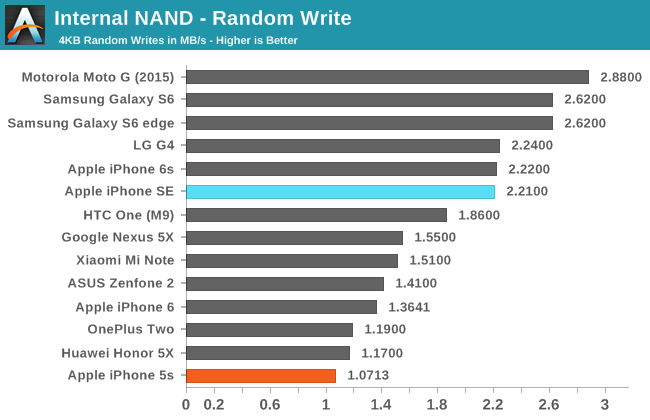
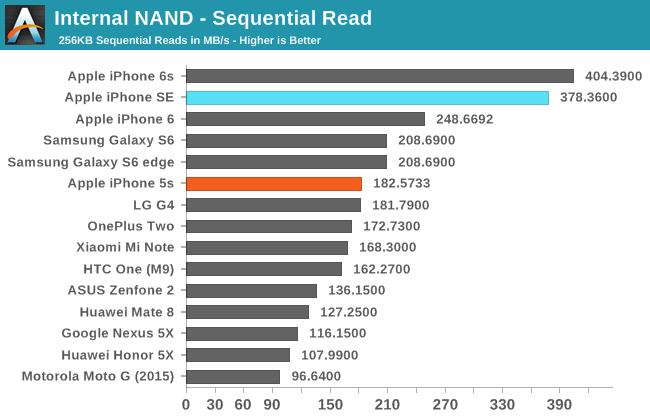
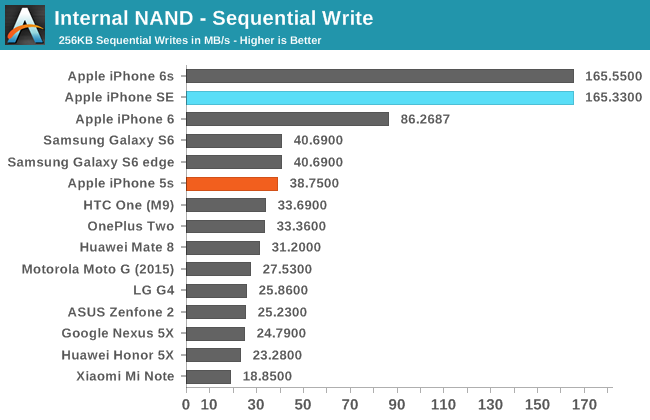
Despite the fact that the storage capacity is half that of our iPhone 6s review unit, the iPhone SE performs essentially just as well. Random reads actually end up being faster, while random writes are nearly identical. Sequential reads trail the 6s by a bit, but sequential writes end up being identical much like random writes. The differences are enough to attribute to testing variance, and it's probably safe to say that the storage performance on the 64GB iPhone SE is identical to that of the 64GB and 128GB models of the iPhone 6s.










138 Comments
View All Comments
name99 - Monday, May 16, 2016 - link
So your complaint with the screen is WHAT exactly? What was so bad about the 5/5S screen that reusing it was unacceptable? You want change simply for the sake of change? Have you actually even SEEN the screen in real life?This is the sort of idiotic complaint that makes Apple fans so irritated with the haters, a complaint that is so OBVIOUSLY utterly content-free.
Eden-K121D - Tuesday, May 17, 2016 - link
Viewing angles suckname99 - Monday, May 16, 2016 - link
"Apple’s A9 SoC is still one of the fastest chips you’ll find in a smartphone"Wow, someone's trying REALLY hard not to praise Apple. Please tell us the names of these other chips of faster to comparable speed...
Because what I see in the reviews is that on single-threaded benchmarks Apple's CPU from three years ago is spanking the best Android can offer today, and the SE has a CPU that's twice as fast as that...
You can obviously buy octacore (or hell, decacore) mobile CPUs which have aggressive parallel performance. But that is not "fast", not by the intuitive definition, and not in terms of pretty much any real world workload.
CloudWiz - Monday, May 16, 2016 - link
Haha, first comment I've seen where someone is hating because they're pro- instead of against- Apple on an iPhone review.He says "one of the fastest" because chips like SD820 and Exy8890 have only slightly worse single-threaded performance, significantly better multi-threaded performance, and better GPUs to boot. I own a 64GB SE, but there's no denying that both of those chips are beasts. SD has its optimization problems on the S7 but it looks to perform quite similarly to the E8890.
name99 - Tuesday, May 17, 2016 - link
Hard to argue against that claim in the absence of any reliable reviews!The best I can find is this
http://wccftech.com/benchmark-results-show-a9-domi...
which has at least interesting graphs, but I wouldn't especially trust the numbers for 2016 which have god knows what provenance (eg may be released from within Samsung on golden chips to build up S7 buzz), and we have no idea what the throttling characteristics are like.
NA1NSXR - Monday, May 16, 2016 - link
It would've been perfect if they stretched the display out closer to the ends of the chassis, making the display ever so slightly bigger than what's on the 5/5s, but with the same size body.csango - Monday, May 16, 2016 - link
Great review. Across iOS n Android both there is need for 4-4.5 inches smart phones , manufacturers can't just think that trends n users like phablet so we will only manufacturer 6 Inches slabs n bricks. Let some sensibilities prevail in Android too , public fashion choices are ephemeral but good quality and design is eternal. I hope Motorola and Google are paying heed and Apple too esp on the price point they need to look at making 4 inch phones more affordable so ppl latch onto it and then you would see there will be all of sudden market for 4 inches .... it's all a value vs price game in the end.Che - Tuesday, May 17, 2016 - link
Lack of a review of the Galaxy S7 (or any other android of this year) is just pathetic. Really no excuse is reasonable. Yet no problem getting the apple review done.Ian Cutress - Tuesday, May 17, 2016 - link
Different reviewer. Check one of the first comments.Che - Tuesday, May 17, 2016 - link
Yes, saw that already. Also have been following the comments on the other reviews. So I have heard the school work excuses already. But if that is a problem, you need to find a solution. You can't continue forever with an ever increasing backlog of reviews.I have been forced to look elsewhere for the reviews and info I need. In the past I would wait for the AnandTech review due to its depth (always better than other sites),but better is not better if it takes this long.